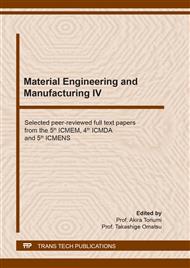p.109
p.116
p.125
p.133
p.139
p.145
p.151
p.159
p.166
Effect of the Environment on the Characteristics of a Polymer
Abstract:
The polycarbonate (PC) is a highly valued polymeric material for its various characteristics and low cost. Its transparency and impact resistance justify its use in a severe radiation and temperature environment. The aim of this article is to subject this material to aging under ultraviolet (UV) radiation with a wavelength of 253 nm and a temperature of 80°C for various times. The physicochemical and mechanical characterizations of the virgin and aged material have allowed the revelation of the aging effects on the properties. The Fourier Transform Infrared Spectroscopy (FTIR) technique highlight breaks in chemical bonds in the molecular chains of the PC subjected to the combined effects of UV and heat. X-ray analysis have showed a reduction in crystallites and a tendency towards an amorphous state at short times, but the degree of crystallinity increases again at long exposure times of the material. As a result, the microhardness of the aged material is strongly affected on the exposed surface with less effect depending on the depth.
Info:
Periodical:
Pages:
139-144
Citation:
Online since:
September 2021
Authors:
Keywords:
Price:
Сopyright:
© 2021 Trans Tech Publications Ltd. All Rights Reserved
Share:
Citation:


